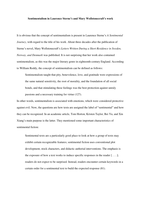Essay
Sentimentalism in Laurence Sterne’s and Mary Wollstonecraft’s work
It is obvious that the concept of sentimentalism is present in Laurence Sterne’s A Sentimental Journey, with regard to the title of his work. About three decades after the publication of Sterne’s novel, Mary Wollstonecraft’s Letters Written During a Short Residence in Sweden, Norway, and Denm...
[Meer zien]





